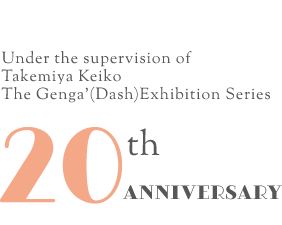The course of Genga’ (Dash)
- Artists who have participated in Genga’ (Dash) project
- Asuka Sachiko, Asuna Hiroshi, Imamura Yoko, Ueda Toshiko, Uehara Kimiko, Ohya Chiky, Kai Yukiko, Kitajima Yoko, Sasaya Nanaeko, Sato Shio, Tomoe Satoo, Takahashi Macoto, Tadatsu Yoko, Chiba Tetsuya, Nagayasu Takumi, Nishitani Yoshiko, Hatsu Akiko, Hanamura Eiko, Higashiura Mitsuo, Hirata Hiroshi, Fujii Chiaki, Maki Miyako, Matsumoto Katsuji, Mizuno Hideko, Murakami Motoka, Watanabe Masako (In the order of the Japanese syllabary)
- Supervisor
- Takemiya Keiko
Activities of Genga’ (Dash) in Japan and abroad
As Genga’ (Dash) are indistinguishable from the originals and can stand long exhibition periods, they have been playing an active role in exhibitions in Japan and abroad.
Please check out a part of activities of Genga’ (Dash) in pictures and a video below.

Exhibition “Shojo Manga! Girl Power! : What can shojo manga tell you?” (2005-2007)
This exhibition started in Chico in California and traveled to 11 cities in North America. A part of the exhibits in the exhibition were Genga’ (Dash). In 2008, a renewed version of the exhibition was held in 4 places in Japan.

Exhibition “L'univers des mangas pour adolescentes” at Pompidou Center in Paris, France (2012)
This exhibition was planned to introduce the history of shojo (girls’) manga through Genga’ (Dash) of 14 artists who represent shojo manga.

Exhibition “MANGAMANIA” in Augustusburg castle in Germany (2017)
This unique exhibition in the historical castle was organized to introduce Japanese popular culture, including manga. 10 Genga’ (Dash) pieces of Watanabe Masako, one of the most influential shojo manga aritsts, were showcased in the exhibition. Due to popularity beyond imagination, the exhibition period was extended, and in the end, the exhibition was held for over a year. It is no exaggeration to say that it was a chance to show the durability of Genga’ (Dash).

Exhibition “Genga’ (Dash) de miru Showa no shojo manga” at the Museum of Fragrance, Iwata (2018)
With the theme of shojo manga from the Showa era (1926-1989), around 80 Genga’ (Dash) pieces of nine manga artists were showcased in the exhibition. It is not always easy to gather several artists’ manga in one place. However, it worked out well for this exhibition because Genga’ (Dash) are collected and managed by Kyoto Seika University International Manga Research Center and Kyoto International Manga Museum.

Exhibition “L’univers du shojo manga” in Alsace, France (2019)
This exhibition was organized by European Center for Japanese Studies in Alsace with support of the prefectural assembly of Haut-Rhin. About 70 pieces of Genga’ (Dash) were on display at the exhibition. One of the exhibition venues was the assembly hall of Haut-Rhin, and the hall was not a great place for an exhibition since there was some sunlight inside of the building. However, we were able to realize our goals for the exhibition perfectly thanks to Genga’ (Dash).

Exhibition “The Citi exhibition Manga” at the British Museum in London, the United Kingdom (2019)
The manga exhibition received attention from all over the world since it was organized on the largest scale for a manga exhibition held outside of Japan. In the exhibition, there was a section to introduce the goal and significance of Genga’ (Dash) and some Genga’ (Dash) were also on display.
Exhibition “Shojo Manga -An Introduction-” at the Japan Foundation, New Delhi (2020)
This exhibition was organized by the Japan Foundation and all of the works on display were Genga’ (Dash). At the middle of the exhibition period, the exhibition was suspended since a nationwide lockdown was ordered in India due to COVID-19. However, it did not cause any significant problems, since Genga’ (Dash) were showcased instead of original drawings.































